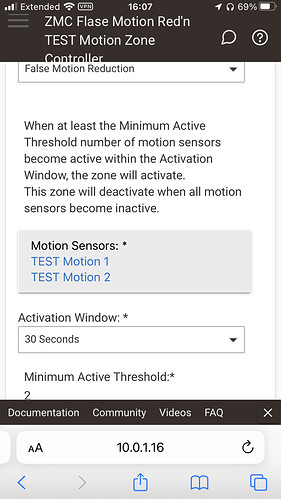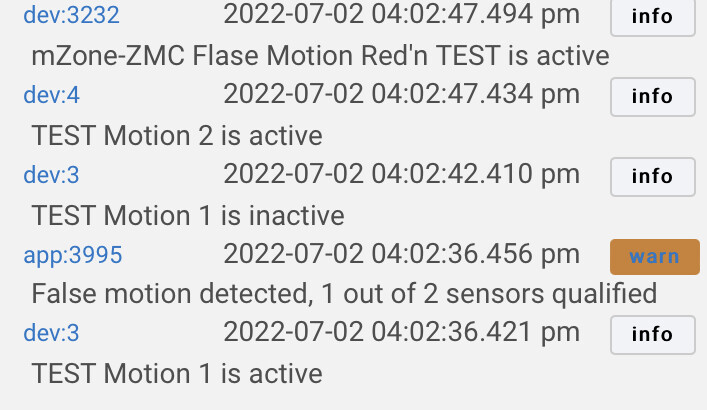I have a motion zone set up from two virtual motion sensors which are connected to alerts from my Reolink cameras. My intention (or how I thought I had set it up) was that if they were both triggered within one minute, it would cause a positive motion result for the zone. Each virtual sensor is configured to go auto-inactive after 15 seconds. Although they were both triggered within the one minute, one of them had gone inactive before the other was activated. I would have liked it to give a positive for the zone.
What is my best solution - increase the timeout for active on each virtual motion sensor or change the "Zone Type" to Motion Aggregation or Triggered Activation? What do they even mean lol?
With False Motion Reduction BOTH sensors have to be active to turn on the virtual device.
The activation window is the time it will wait after the first sensor becomes active for the second one to become active. i.e. BOTH must be active.
From the App.
False Motion Reduction When at least the Minimum Active Threshold number of motion sensors become active within the Activation Window, the zone will activate. This zone will deactivate when all motion sensors become inactive.
Motion Aggregation Any motion sensor will activate this zone. The Activity Timeout is started after all motion sensors become inactive. This zone will deactivate when the Activity Timeout expires, and no further motion was detected.
Triggered Activation This zone will activate when any motion sensor becomes active within the Activation Window. The Activation Window is enabled by the Trigger Devices(s). The Activity Timeout is started after all motion sensors become inactive. This zone will deactivate when the Activity Timeout expires, and no further motion was detected.
The words for False Motion Reduction don't seem to fit what actually happens. If they've both got to be simultaneously active, there is no point to the Activation Window
I think the idea of it is if one of your sensors activates from a pet or maybe if your sensor is super sensitive, by curtains opening. I have a sensor that does activate in the morning when the curtains open.
This is false motion.
I use false motion detection to mitigate this. Both sensors must be active to activate this zone and I have set it up to wait a minute for both sensors to be active. This stops my lounge zone going active when the curtains open and nobody is in the room.
Well that's a way of doing it, but if that was the intention of False Motion Detection mode, then the wording is incorrect and the Activation Window is pointless, since any overlap of Active state between the specified minimum of devices should be a positive for the zone.
They don't have to both (or however many) be active at the same time, just become active within the specified window of time--i.e., with two sensors, it will still count if the first sensor goes back to inactive before the second becomes active if it's still within that window.
In that case there is something wrong. The two definitely both became active within the window - just not overlapping. Let me find the log entries...
The zone has description text logging enabled, and also I would have got a line logged in my custom logging file had the zone been active as per set up
App 168 is the zone in question, App 266 is another overlapping zone, and that would have been correct for that one.
I'm not sure this is true. We need a higher authority to just clarify.
I know it's Saturday but I'll bring in @bravenel (if you do not mind Bruce) to clarify.
@mike.maxwell actually wrote this one, but I think I tested this with virutal devices a while back (because I also wasn't sure) and found this. It's mostly moot for me in the real world because any interval I use my sensors overlap with anyway, so maybe I just don't remember...
Just tried this again and it works for me as I described above, assuming we're talking about the same configuration. Note how the first sensor went inactive before the second became active, but the zone motion sensor still became active when the second sensor became active within the window.
1 Like
Is there any possibility that the anomaly is caused by me having one motion device in two zones?
I can't imagine so, but someone who knows how the app tracks things (I'd imagine in app-specific state) would have to say. It would also be easy to test by disabling the other app(s).
The general principle would have to be that two apps subscribed to the same event can't both get the message - but I can't imagine that to be the case or the forum would be full of bug reports !
Any number of apps can subscribe to the same events--that's definitely not a problem. The issue I alluded to above would be if multiple instances of the app happen to share a data structure where they track the device state in a way where one steps on the other's toes (e.g., a static field--usually recommend against unless it's a Map indexed by app ID, or just use state instead). This seems unlikely, but again, disabling an app would still test this if you're curious. No app code, including waking for subscriptions, would run.





